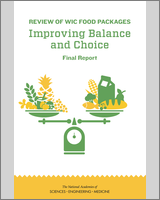From: 2, The WIC Program: Changes Since the Last Review and Continuing Challenges

NCBI Bookshelf. A service of the National Library of Medicine, National Institutes of Health.
| Stakeholder | Challenge | Resolution |
|---|---|---|
| Federal | Dangling quart: after substitution options, a quart of milk remained, creating a stocking challenge for vendors | Yogurt substitution option in place of the “dangling quart”; states are permitted to authorize purchase of quart sizes of milk (USDA/FNS, 2014a) |
| Container size: change in sizes of peanut butter from 18 to 16 ounces, and in some juices from 64 to 59 ounces | Permission for state authorization of different sizes as approved by USDA-FNSa (USDA/FNS, 2016a) | |
| CVV: A new food instrument based on a fixed cash value | Permission for “split tender” so that participants can cover any overage with cash (USDA/FNS, 2014a) | |
| Federal/State | CVV: A new food instrument based on a cash value; difficult for participants to select an amount of produce that exactly matched the value | Education to staff, participants, and vendors |
| State agency | CVV in lieu of jarred infant food vegetables and fruits (currently fresh only) for infants 9 to 11 months of age; difficult if states offer canned, frozen, or dried vegetables and fruits for other participants | No resolution; some states have not implemented the option because of Management Information System limitations |
| EBT: requires development of a database for WIC-approved foods | Established strategies by early EBT adopters, a model for later adopters; development of a national UPC database is required for state use (P.L. 111-296, Healthy, Hunger-Free Kids Act of 2010) | |
| Cost containment: balancing with diversity and availability of foods | Not fully resolved: rebates contain costs, but limit program ability to support breastfeeding; cost-containment may limit vendors, brands, sizes, forms, or prices (e.g. “least expensive brand”b requirements) | |
| Container size: change in sizes of peanut butter from 18 to 16 ounces, and in some juices from 64 to 59 ounces and in some juices from 64 to 59 ounces | Permission for state authorization of different sizes as approved by USDA-FNS | |
| Local agency | Introduction of new foods or changes to foods | Staff and participant education |
| Vendor | Requirement in the Final Rule to stock at least two different fruits and two different vegetables | Vendors' choice of less perishable options or canned/frozen varieties if the state authorizes canned, frozen, or dried options (USDA/FNS, 2015a) |
| Stocking the specific size; maintaining freshness (Gleason et al., 2011) | Higher prices for WIC foods (Tisone et al., 2014; USDA/ERS, 2014a) | |
| Difficulty finding distributors and suppliers for specific food items (Andreyeva et al., 2011; Gittelsohn et al., 2012) | ND | |
| Manufacturer | Specific size or product with the WIC food specification not available | At higher cost, modified production streams to manufacture the required product; or prohibitive cost so the product is not manufacturedc |
NOTES: CVV = cash value voucher; EBT = electronic benefit transfer; ND = No data are available as to whether this continues to be a challenge; UPC = Universal Product Code; USDA-FNS = U.S. Department of Agriculture's Food and Nutrition Service.
States are permitted to authorize different sizes only if there is limited availability of the prescribed specified size and nutritional integrity is not compromised (see USDA/FNS, 2016a).
The “least expensive brand” requirement is a strategy selected by some states by which participants are directed to the products that are the least expensive among all products offered by that store that meet WIC specifications.
Personal communication, National Pasta Association, July 16, 2015. Report is available in the public access file for this study (Email: paro@nas
SOURCES: As cited in the table.
From: 2, The WIC Program: Changes Since the Last Review and Continuing Challenges

NCBI Bookshelf. A service of the National Library of Medicine, National Institutes of Health.